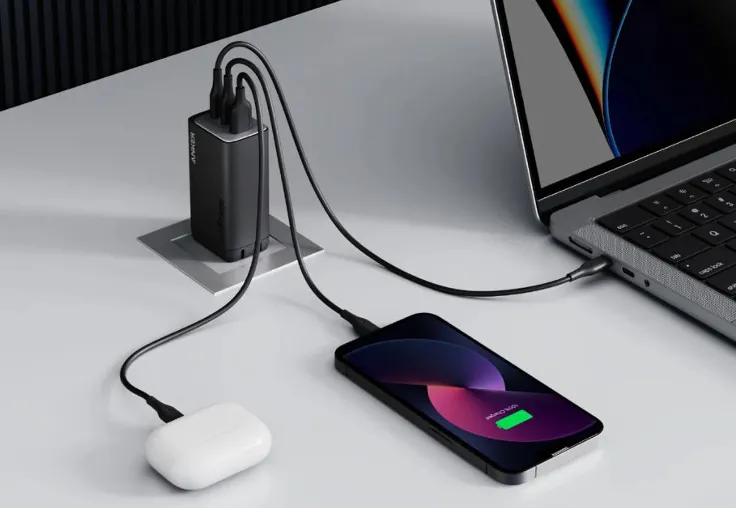In today’s fast-paced digital age, our devices have become an indispensable part of our lives. From smartphones to laptops, tablets to smartwatches, we rely heavily on these gadgets to stay connected and productive. However, all the features and capabilities of these devices would be useless without a reliable power source. That’s where the importance of choosing the right charger comes into play. In this guide, we’ll break down the key factors to consider when selecting the perfect charger for your device.

Understanding Your Device’s Charging Requirements
Before delving into the world of chargers, it’s essential to understand your device’s charging requirements. Different devices have varying power needs, and using the wrong charger could potentially damage your device or result in slower charging times.
Check Your Device’s Charging Port
The first step is to identify the type of charging port your device has. Most devices nowadays use either USB Type-A, USB Type-C, or Apple’s Lightning port. USB Type-C has become increasingly common due to its universal nature and fast charging capabilities. Make sure your charger’s cable matches your device’s port to ensure a secure and efficient connection.
Determine Power Requirements
Next, you should determine your device’s power requirements. This information is usually provided in the device’s manual or on the manufacturer’s website. Look for the wattage and voltage specifications. Using a charger that provides less power than your device requires might lead to slow charging, while using a charger with significantly higher power might damage your device’s battery over time.
Types of Chargers Available
Chargers come in various shapes and sizes, each with its own set of features. Understanding the different types of chargers can help you make an informed decision.
Standard Wall Chargers
Standard wall chargers are the most common type of charger and usually come bundled with your device. They provide a steady and reliable charge but might not support fast charging. These chargers are ideal for overnight charging or when you have ample time to recharge your device.
Fast Chargers
Fast chargers are designed to deliver a higher amount of power to your device, resulting in quicker charging times. They are especially useful when you need to top up your device’s battery in a hurry. Some devices and chargers support technologies like Qualcomm’s Quick Charge or USB Power Delivery (USB PD), which can further enhance charging speed.
Wireless Chargers
Wireless chargers have gained popularity for their convenience and clutter-free charging experience. They work by transferring energy from the charger to the device through electromagnetic fields. While wireless charging is generally slower than wired charging, it’s incredibly convenient for topping up your device throughout the day without the hassle of plugging and unplugging cables.
Ensuring Safety and Compatibility
While charging your devices efficiently is essential, safety should never be compromised. Using an incompatible or low-quality charger can lead to overheating, battery damage, or even fire hazards. Here’s how to ensure safety and compatibility.
Stick to Official Accessories
Whenever possible, opt for chargers and cables provided by the device manufacturer or reputable third-party brands. Cheap and uncertified chargers might not adhere to safety standards, putting your device at risk. Genuine accessories may be slightly pricier, but they’re an investment in your device’s longevity.
Look for Safety Certifications
Chargers with safety certifications like UL (Underwriters Laboratories) or CE (Conformité Européene) have undergone rigorous testing to ensure they meet safety and performance standards. When browsing for chargers, check for these certifications as a sign of quality and safety. For example, if you have an iPhone, you should look for a safety certificate when buying an iphone charger. iPhones are known for their high-quality build and rigorous safety standards, and using a charger that doesn’t meet these standards can potentially jeopardize your device’s performance and safety.

Travel-Friendly Charging Solutions
For the globetrotters and frequent travelers, having a reliable charging solution is crucial. Here are some considerations for choosing travel-friendly chargers.
Universal Voltage Support
When traveling internationally, voltages can vary from country to country. Look for chargers that support a wide range of voltages (e.g., 100-240V). This ensures your charger can be used worldwide without the need for voltage converters.
Compact and Portable Designs
Travel-friendly chargers should be compact and lightweight, making them easy to pack and carry. Some chargers even come with interchangeable plugs for different regions, eliminating the need for bulky adapters.
Conclusion
Choosing the right charger for your device might seem like a small decision, but it can have a significant impact on your device’s performance, battery life, and safety. By understanding your device’s charging requirements, considering different charger types, prioritizing safety and compatibility, and factoring in travel needs, you can make an informed choice that ensures your devices are always powered up and ready to go.
Remember, the charger you choose is an investment in the longevity and reliability of your devices, so take the time to research and choose wisely. Your devices will thank you with seamless performance and a longer battery life.